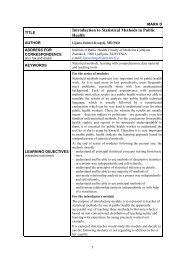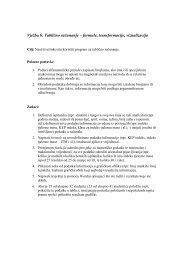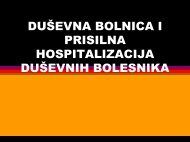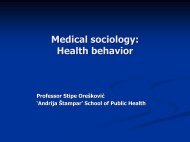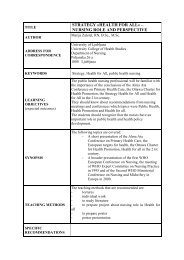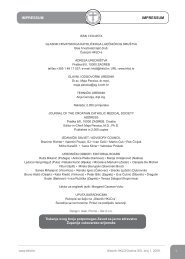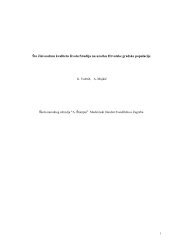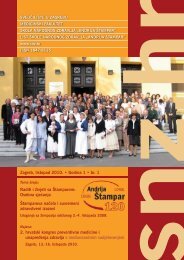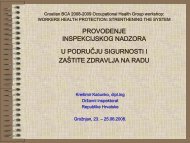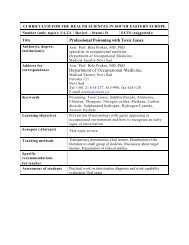Institution Ass. Prof. Ivan Mikov, MD, PhD
Institution Ass. Prof. Ivan Mikov, MD, PhD
Institution Ass. Prof. Ivan Mikov, MD, PhD
Create successful ePaper yourself
Turn your PDF publications into a flip-book with our unique Google optimized e-Paper software.
Title<br />
Author(s)<br />
<strong>Institution</strong><br />
Address for<br />
correspondence<br />
MARK D<br />
International Classification of Radiographs of<br />
Pneumoconioses<br />
<strong>Ass</strong>. <strong>Prof</strong>. <strong>Ivan</strong> <strong>Mikov</strong>, <strong>MD</strong>, <strong>PhD</strong>,<br />
Specialist in Occupational Medicine<br />
Department of Occupational Medicine,<br />
Medical Faculty, University of Novi Sad, Yugoslavia<br />
Department of Occupational Medicine,<br />
Medical Faculty, University of Novi Sad<br />
Futoska 121,<br />
21000 Novi Sad, FR Yugoslavia<br />
Tel. + 381 21 613 998, 614 277, Fax: + 381 21 624 128<br />
e-mail: driva@eunet.yu<br />
Keywords Pneumoconiosis, Chest radiograph, Classification, International<br />
Labour Office, Occupational lung disease, Worker, Health<br />
surveillance<br />
Learning objectives<br />
(expected outcome)<br />
Synopsis (Abstract) Definition of pneumoconiosis<br />
Definition and objective of the radiographic classification of<br />
pneumoconioses<br />
Features of the ILO classification system<br />
I. Technical quality<br />
II. Parenchymal opacities<br />
III. Pleural abnormalities<br />
IV. Symbols<br />
Uses of the classification<br />
1. Workers health surveillance<br />
2. Epidemiological research<br />
3. Compensation<br />
4. Education and training<br />
References<br />
Teaching methods - Introductory lecture with transparencies<br />
- Distribution of the ILO short scheme of the classification<br />
during the lecture<br />
- Presentation of 22 standard chest radiographs of<br />
pneumoconioses on a view box<br />
- Presentation of pneumoconiosis clinical case reports,<br />
comparison of their chest radiographs with the standard<br />
radiographs on a view box and interpretation<br />
Specific recommendations .<br />
for teacher<br />
<strong>Ass</strong>essment of<br />
students<br />
Recommendation for<br />
module evaluation<br />
Written exam: multiple-choice questions.
International Classification of Radiographs of Pneumoconioses<br />
<strong>Ivan</strong> <strong>Mikov</strong>, <strong>MD</strong>, <strong>PhD</strong>, Department of Occupational Medicine,<br />
Medical Faculty, University of Novi Sad, Novi Sad, FR Yugoslavia<br />
Outlines of the lecture:<br />
Definition of pneumoconiosis:<br />
The term pneumoconiosis is used to cover group of lung diseases, which result from the<br />
inhalation of dust and should be used for all dust damage to the alveolar part of the<br />
lung, including the airways that have no mucociliary lining.<br />
Definition and objective of the radiographic classification of pneumoconioses:<br />
The International Labour Office (ILO) has issued an internationally accepted standard<br />
method for the classification of the radiographic changes seen in pneumoconiosis. The<br />
ILO has published the last revision in 1980.<br />
The ILO classification, which is based on the posteroanterior chest radiograph, is a<br />
descriptive system consisting of a glossary of terms and a set of 22 standard radiographs<br />
illustrative of the parenchymal and pleural changes of the pneumoconioses.<br />
The objective of the classification is to enable the radiographic changes seen in<br />
pneumoconioses to be coded in a simple reproducible form.<br />
The method of reading the radiographs is to compare each worker's radiograph with a<br />
set of standard radiographs supplied by the ILO.<br />
Features of the ILO classification system:<br />
I. Technical quality:<br />
The classification requires films of excellent quality. The accurate classification of poor<br />
quality films remains a problem. The reader's opinion about the film quality is recorded<br />
as 1,2,3 or 4 i.e. unreadable.<br />
II. Parenchymal opacities:<br />
The classification grades the parenchymal pattern of the pneumoconioses based on<br />
shape, size extent and profusion.<br />
a.) Small opacities:<br />
- <strong>Prof</strong>usion (numbers: 0, 1, 2 and 3 combined in binary fashion) e.g. 2/2 or 2/3<br />
- Extent (lung fields - RU, RM, RL, LU, LM and LL)<br />
- Shape and size (two-letter combinations: round shape - p, q, r and irregular shape - s, t,<br />
u) e.g. q/q or q/t
.) Large opacities (capital letters: A, B and C)<br />
III. Pleural abnormalities:<br />
Pleural thickening and pleural calcification are also categorized and quantified.<br />
IV. Symbols:<br />
Recording of other abnormalities seen on the chest radiograph. e.g. em (emphysema), tb<br />
(tuberculosis), ca (cancer) etc.<br />
Uses of the classification:<br />
1. Workers health surveillance<br />
The ILO classification is useful for screening and surveillance programmes, which must<br />
try to recognize early radiographic abnormalities, to identify sentinel health events and<br />
to monitor trends over the time.<br />
2. Epidemiological research<br />
It has proved very useful as a method of classifying chest radiographs for<br />
epidemiological research, identifying health hazards and establishing exposure-response<br />
relationships.<br />
3. Compensation<br />
4. Education and training<br />
References:<br />
1. International Labour Office. Guidelines for the use of ILO international<br />
classification of radiographs of pneumoconioses. Occupational safety and health<br />
series No. 22 (Rev. 80). Geneva: International Labour Office, 1980.<br />
2. Rossiter CE, Jones RN. Radiographic classifications. In: McDonald JC (ed.). Recent<br />
advances in occupational health. Edinburgh: Churchill Livingstone, 1981: 129-40.<br />
3. <strong>Mikov</strong> M, <strong>Mikov</strong> I. Occupational Medicine. Belgrade: Naucna knjiga, 1995: 124-<br />
34. (In Serbian)<br />
4. Wagner GR. Screening and surveillance of workers exposed to mineral dusts.<br />
Geneva: World Health Organization, 1996: 52-7.



